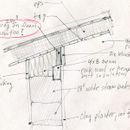Spray on foam needed on inside of rafter blocking?
Hello,
I am building a straw bale home in southern Idaho. “Cold” region, and dry.
Thus far, the build is as shown in the sketch…..minus the spray foam against the exterior blocking (circled in red), and batt insulation above the straw bales.
Regarding that spray foam insulation against the blocking: I have in my notes that it needs to be 2.5″ thick….something I believe to have gotten from Joe Lstiburek. However, as I am trying to remember exactly how I came to this, and the context, I’m second guessing my need for the spray on insulation. It seems I remember Joe (or someone else?) say how critical this was…but, I seem to recall the context being a rim joist in a crawl space. I’m trying to remember the reason for it too….perhaps to keep it warm to prevent condensation from forming….the last thing I want in my situation where it could run down on top of my straw bales.
At any rate, what I’m trying to figure out is if the spray foam insulation is even needed in my case. I am hoping it is not, as it would save me a heap of trouble right now. On the other hand, I will happily apply it if is felt to be necessary.
Thoughts?
GBA Detail Library
A collection of one thousand construction details organized by climate and house part










Replies
dean bowman,
A lot depends on how you are planning to air-seal. The foam along the perimeter of floor framing is there to stop moist interior air from getting to the cold rim-joist and condensing. We don't have to worry about that on other part of the structure if there are adequate air barriers and vapour retarders.
What stops air from moving through the top of the wall above the straw bales? If you want to rely on the sealed foam as an exterior air-barrier it somehow needs to extend down over your 4"x8" beam and be connected with whatever acts as an air-barrier on your straw bale walls.
One small note: You will find everything a lot easier if you run your interior and exterior blocking at 90 degrees to your rafters.
Thanks for your input.
Sealing is going to take some effort....being that the blocking, inside and out, will be exposed...and the fact the rafters are exposed, inside and out. As little fun as it sounds, I was thinking that I'd seal via caulking. It will be difficult to do well (esthetics & otherwise)....but I haven't a better solution.
As for the 4x8, the clay plaster will go over it and continue down the wall over the straw bales.
Also, the original plan was to run the plaster over the blocking right up to the underside of the T&G....on the interior and exterior. The plaster would then be applied around each rafter....and, theoretically, offer a decent air seal. That would require cutting and installing lath to fit between each rafter, and carefully plastering all of it. As such, I decided against that plan though thinking it would save a lot of time and headache to do it as per the sketch. But, as I think about it more, I'm not sure how much time it would actually save me. Maybe none.
So, I'm not set on doing it as the sketch shows. I'd like to save myself some time...but I'm more concerned about doing a good job.
deanbowman,
I you can get a good air-seal around the interior blocking, and between it and the plaster wall below, I don't see any advantage to using any spray foam.
Thanks, Malcolm.
Here are a couple pics showing the two different methods I spoke of earlier...in case my explanation was not clear. In one, the plaster goes up the sides of the rafters to the underside of the T&G. In the other, the blocking is exposed with the plaster running to the underside of it. I thought the latter would save me a fair bit of grief and time.
Honestly though, I really don't know how realistic it is to think I could get a great seal with either method. Perhaps....with a enough time spent.
Any additional thoughts or ideas?
deanbowman,
I agree. I'd do the second option both to make construction easier, but also it will be more forgiving as the rafters shrink.
I'm a bit reticent to give advice on how to handle the area above the straw bales because I know so little about how those walls work in terms of air and moisture movement, but my suspicion is you will be fine if you seal as best you can at the interior blocking, and don't add anything impermeable (like foam) to the exterior, so that the area can readily dry to the outside
I hope some other posters chime in as I'd be interested in another take on this.
Thanks again, Malcolm.
I'm no building scientist but, there's a couple good books authored by engineers, explaining well how the straw walls work. The key, as I understand, is to allow them to breath while at the same time, sealing the inside and out to prevent air infiltration...particularly, I believe, on the inside. Vapor barriers/retarders of any kind, inside or out are a big NO NO....as are any sort of paints that do not breath (like standard latex & oil paints). Clay plasters are the preferred (as long as they are adequately protected w/ large overhangs &/or porches), as they are the most breathable. So clay is what I will be using, inside and out. The thickness of the plaster varies from 1-2", each side.
Also, clay is hydrophilic so it is pulling moisture out of the straw. It also pulls moisture out of the air...but I think it is stored in the thick plaster until conditions allow it to dry.
Hope that helps a little.